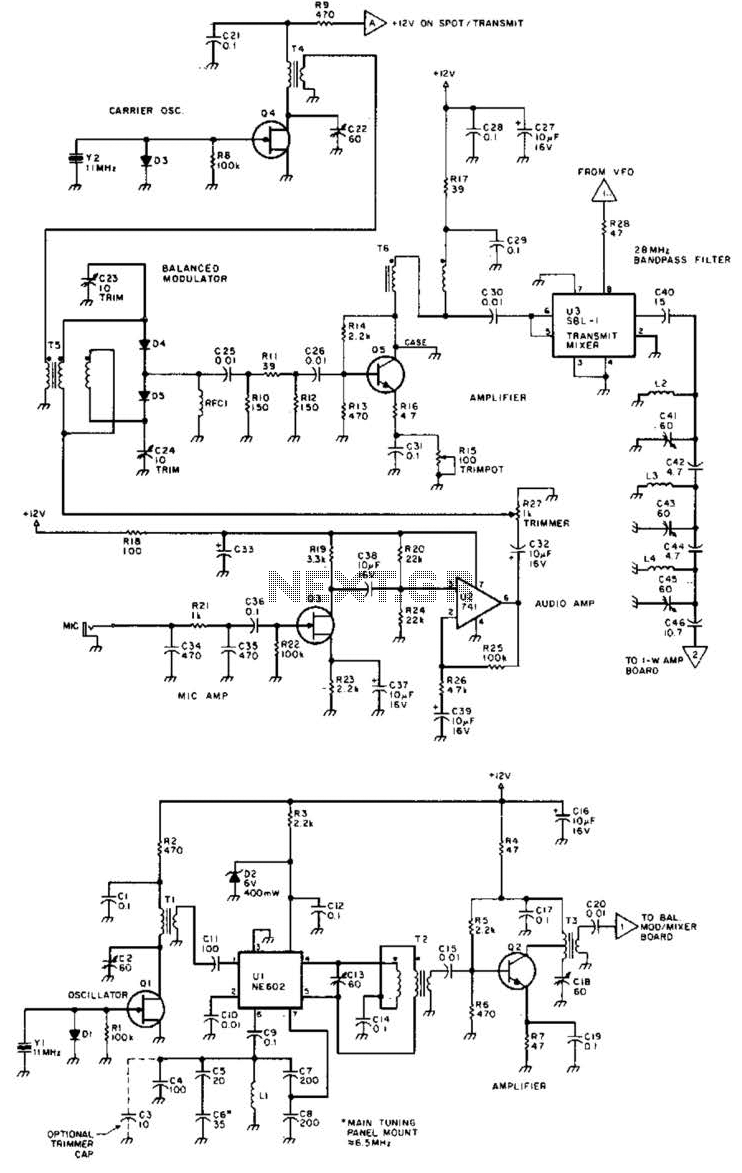
27.125Mhz Nbfm Transmitter Circuit

Using a Motorola MC2833 one-chip FM transmitter, a few support components, and an MPF6660 FET RF amplifier, this transmitter delivers approximately 3 W into a 50-ohm load. It is capable of operation over a frequency range of about 29 to 32 MHz with the components shown.
The described FM transmitter circuit utilizes the Motorola MC2833 integrated circuit, which serves as the core component for FM signal generation. This chip is designed to provide efficient modulation of audio signals onto a carrier wave, making it suitable for short-range broadcasting applications. The MC2833 operates within the specified frequency range of 29 to 32 MHz, allowing for flexibility in tuning and transmission.
Support components are essential for the proper functioning of the MC2833. These components typically include resistors, capacitors, and inductors that help in setting the frequency of oscillation, filtering unwanted harmonics, and stabilizing the circuit. Proper selection and arrangement of these components are critical to ensuring that the transmitter operates within its intended specifications and provides a clean output signal.
The RF amplification stage is achieved using the MPF6660 FET, which is a field-effect transistor known for its high gain and low noise characteristics. This amplifier boosts the output power of the FM signal to approximately 3 watts, which is sufficient for short-range transmission. The output is designed to match a 50-ohm load, which is a standard impedance for RF applications, ensuring maximum power transfer and minimizing signal reflections.
The circuit can be further enhanced with additional features such as a low-pass filter to suppress harmonic frequencies, a power supply regulation circuit to ensure stable operation, and an audio input stage to interface with various audio sources. The overall design of the transmitter must consider factors such as heat dissipation, component tolerances, and layout to achieve optimal performance and reliability in real-world applications. Using a Motorola MC2833 one-chip FM transmitter, a few support components, and an MPF6660 FET RF amp, this transmitter delivers about 3 W into a 50- load. It is capable of operation over about 29 to 32 MHz with the components shown.
The described FM transmitter circuit utilizes the Motorola MC2833 integrated circuit, which serves as the core component for FM signal generation. This chip is designed to provide efficient modulation of audio signals onto a carrier wave, making it suitable for short-range broadcasting applications. The MC2833 operates within the specified frequency range of 29 to 32 MHz, allowing for flexibility in tuning and transmission.
Support components are essential for the proper functioning of the MC2833. These components typically include resistors, capacitors, and inductors that help in setting the frequency of oscillation, filtering unwanted harmonics, and stabilizing the circuit. Proper selection and arrangement of these components are critical to ensuring that the transmitter operates within its intended specifications and provides a clean output signal.
The RF amplification stage is achieved using the MPF6660 FET, which is a field-effect transistor known for its high gain and low noise characteristics. This amplifier boosts the output power of the FM signal to approximately 3 watts, which is sufficient for short-range transmission. The output is designed to match a 50-ohm load, which is a standard impedance for RF applications, ensuring maximum power transfer and minimizing signal reflections.
The circuit can be further enhanced with additional features such as a low-pass filter to suppress harmonic frequencies, a power supply regulation circuit to ensure stable operation, and an audio input stage to interface with various audio sources. The overall design of the transmitter must consider factors such as heat dissipation, component tolerances, and layout to achieve optimal performance and reliability in real-world applications. Using a Motorola MC2833 one-chip FM transmitter, a few support components, and an MPF6660 FET RF amp, this transmitter delivers about 3 W into a 50- load. It is capable of operation over about 29 to 32 MHz with the components shown.





